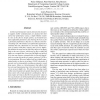Free Online Productivity Tools
i2Speak
i2Symbol
i2OCR
iTex2Img
iWeb2Print
iWeb2Shot
i2Type
iPdf2Split
iPdf2Merge
i2Bopomofo
i2Arabic
i2Style
i2Image
i2PDF
iLatex2Rtf
Sci2ools
MASCOTS
2004
2004
An Optimisation Model for a Two-Node Router Network
Architectural designs for routers and networks of routers to support mobile communication are analysed for their end-to-end performance using a simple Markov model. In view of the diverse design options, such models have many adjustable parameters and choosing the best set for a particular performance objective is a delicate and timeconsuming task. We introduce an optimisation approach to automate this task, illustrated in a two-node, tandem network of routers with finite capacity and recovery buffers. We minimise the mean end-to-end delay subject to an upper limit on the rate of losses, which may be due to either full buffers or corrupted data. Losses at a full buffer are inferred by a time-out whereas corrupted data is detected immediately on receipt of a packet at a router, causing a N-ACK to be sent upstream. Recovery buffers hold successfully transmitted packets so that on receiving a N-ACK, the packet, if present, can be retransmitted, avoiding an expensive resend from source. H...
| Added | 31 Oct 2010 |
| Updated | 31 Oct 2010 |
| Type | Conference |
| Year | 2004 |
| Where | MASCOTS |
| Authors | Nalan Gülpinar, Peter G. Harrison, Berç Rustem, Louis-François Pau |
Comments (0)

